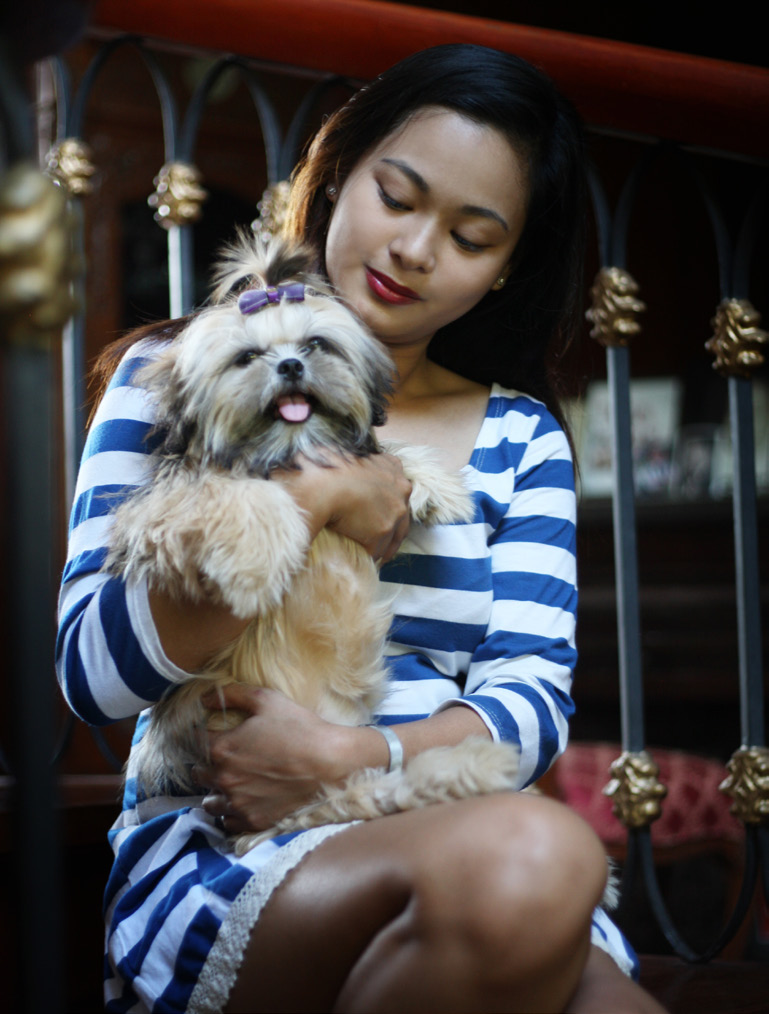In our November issue, we introduced you to Che Vienes and you got to read two of her dog lover stories. Here’s a treat: the second part of her 21 stories! Pet Photography Advice from Che
Pet Photography Advice from Che
Want to take photos of pets? Che has some good advice for you.
- Always remember that not all pets understand what you want them to do…they won’t just pose for the camera on command, unlike humans.
- Don’t be afraid of photographing pets that aren’t your own. Your attitude will influence theirs.
- You have to make them feel that they’re safe. Limit distractions. Make them comfortable—first with you, then their surroundings.
- If you’re going to shoot at a studio or outdoors, consider their mood. “Taking photographs of uncomfortable pets can be as difficult as shooting a starry night, trust me,” she warns.
- Consider lighting. Che believes “…you do not need special gear for an outdoor photo session. Avoid [using a] flash for [an] outdoor photo session with pets. Use natural light. If you are thinking [of using a] flash, [let me] remind you that it will not only [result in] a red-eyed animal photograph, but [the flash will] also make the pet nervous. If you’re going to set up a photo session indoors or [at a studio], as much as possible, use [a steady or continuous] light.
- Be patient. If you’re having your pet photographed, bring some toys and your pet’s favorite cat/dog treats. If you’re doing the photos, supply some toys or treats. “Good pictures with pets [result from good] timing, and [the] mood of the pet itself.” It’s important to relax a cat or a dog, especially if it’s excited or afraid.
- Pay attention to their eyes and tail. “Remember the rule of thirds; it will be pleasing for a close up shot if you focus on the closest eyeball in your framing composition.”
- Take your time and think of a concept as you enjoy the photo session with your pet. You should consider different angles. Shoot as long as you like so that you can achieve what you have in mind. And most of all, if you’re the photographer and not the pet owner, don’t be afraid of the pet!
Mercy’s Journey

Given how many Pinoys abandon pets who are ill, 23-year-old Coleen Sarte is a sterling exception. She personally administers therapy to her dog, who suffers Swimmer Puppy Syndrome (pectus excavatum). This means Mercy was born with a flat chest and abdomen, which prevents her from standing or walking—those like her can only get around by flailing their limbs in a swimming motion, hence the name of the condition.
Coleen first noticed the problem two weeks after her Shih Tzu gave birth. Mercy could not bend her hind legs, pulling herself along as best she could. Then she suddenly stopped nursing and just lay there, listless. When the vet told Coleen it was a congenital problem, she realized that Mercy would need special care for her entire life.
It didn’t help when a sibling accidentally poked Mercy in the eye and damaged it so badly, even the vet thought Mercy would be blind in that eye. She was also the runt of the litter, only receiving her vaccinations at three months of age because she was underweight for her age. Despite all this, Mercy recovered—regaining the sight in the injured eye with just some scarring—and became very cheerful and sweet.
Today, Mercy is very active despite her condition and size. Coleen continues to try and help Mercy learn how to walk, taking her into the sun every day and purchasing vitamins to help give the little one a fighting chance.
And from the looks of it, this little stalwart heart may just win her fight.
Therapy Dog

One-year old Kipper joined Clarice Timones Abanilla’s family as a companion for her autistic son. The Manila-based mom says, “Ever since we had [Kipper], life is more wonderful. When my son has his meltdowns, he will call for Kipper. He wants Kipper to sleep in our room too. Only sometimes, when he’s really not in the mood, he [picks] on Kipper…[pulling on] his fur most of the time…I think our dog knows that Evo, my son, is special, [which is] why he [puts up with this treatment].”
Yet Evo is protective of Kipper, getting upset if anyone shouts at the dog. Evo will shout back at that person, or even yank on their shirt.
While therapy dogs are not yet a common sight in the Philippines, there are autism assistance dogs—and they are unique among dogs that help people. Dogs like Kipper help reduce stress for family members; promote positive changes in an autistic child’s behavior; and provide comfort when autistic children are upset. Autism assistance dogs, Che notes, help improve the quality of life for families of children living with autism.
The Companion

The film “Hachiko,” based on a real-life dog who loyally continued to wait for his master at the Shibuya station nine years after the master died, moved Kim Pasco greatly. Prior to that, she had owned small dogs, including her female Chihuahua, and she decided to add Gon, who was of a bigger breed, as a guard dog. She fell in love with the tiny Rottie who was the sole male in his litter and who appeared to be bullied by his sisters.
Most of the time, Kim is alone. “…but [this doesn’t bother me] since I’m with all my fur kids: 4 Chihuahuas, 1 toy poodle, 1 pit bull, and 1 Rottweiler…I feel safe around them.” She adds that her stress and sadness are banished by her critters, who never fail to cheer her up, and she’s had them since she was in her third year of college—and now, she has her own family!
This appeared in Animal Scene’s December 2016 issue.






